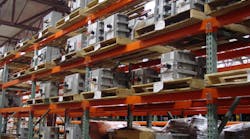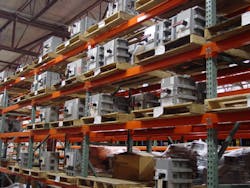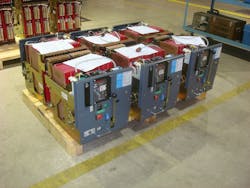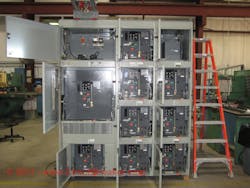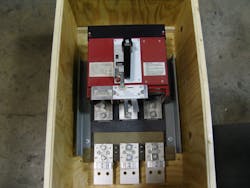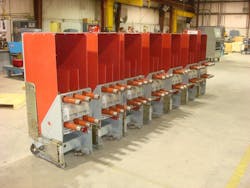When the NFPA added expanded rules for reconditioning in the 2020 NEC, it couldn’t have imagined how a global pandemic would spur the market for reconditioned equipment less than a year later. Nor could NEMA when it released its Policy on Reconditioned Electrical Equipment in 2019.
Reconditioned commercial and industrial electrical equipment has been available for decades. But by the mid-2010s, the market had grown and matured to the point the 2017 NEC added language to address it.
As noted in Sec. 110.21(A)(2), “Reconditioned equipment shall be marked with the name, trademark, or other descriptive marking by which the organization responsible for reconditioning the electrical equipment can be identified, along with the date of the reconditioning. Reconditioned equipment shall be identified as ‘reconditioned’ and approval of the reconditioned equipment shall not be based solely on the equipment’s original listing.” An exception allowed industrial occupancies, where conditions of maintenance and supervision ensure that only qualified persons service the equipment, to bypass this marking requirement.
The 2020 Code went a step further by expanding the rules on marking in Sec. 110.21(A)(2), adding a new definition for “reconditioned” in Art. 100 and specifying the equipment types that can be refurbished, such as low- and medium-voltage power circuit breakers, switchboards, and switchgear. In its “Technical Position on Reconditioned Equipment” guide, NEMA recommends “first seeking approval by the original manufacturer, using their guidance or other industry-developed standards, using qualified parts, and using only qualified workers to perform reconditioning tasks.”
All this NEC and NEMA guidance became particularly handy when the pandemic began to limit the availability of brand-new equipment.
“We’ve been relying heavily on refurb since COVID just because of how it’s affected everything in this industry,” says Joseph Martin, manager of procurement at Pittsburgh-based Sargent Electric. “Plants are shut down. Things are backordered. We’ve gone to our customers and said: ‘Here’s an option. We can get this completed in the five weeks you want, or it’s going to take us 12 just to get the materials.’”
Nationalism and cybersecurity spur demand
Politics also are driving demand for refurbished equipment. For example, the Trump administration implemented environmental, tax, tariff, and other policies aimed to spur manufacturing.
“We’ve seen a recovery because Trump had a big push for U.S. manufacturing,” says Paul Grein, vice president of Circuit Breaker Sales, a Gainesville, Texas-based provider of refurbished electrical equipment. “We saw some recovery from the steel industry especially over the last four years.”
The Biden administration’s “Made in America” policies include a host of credits and penalties to encourage construction of new factories and modernization of existing ones, as well as requiring federal agencies to purchase domestically. That could increase factory demand for reconditioned gear.
In some verticals, users prefer refurbished older equipment for cybersecurity reasons.
“We do work at nuclear plants, and they won’t take the modern equipment because they’re scared to connect it to the internet,” says Bill Schofield, Circuit Breaker Sales vice president of business development.
Politics plays a role here, too. In May 2020, President Trump signed an executive order aimed at thwarting the kinds of cyberattacks that crippled electrical grids in places such as the Ukraine. That led to a Department of Energy order prohibiting the use of China-made “bulk-power system electric equipment” in substations, control rooms, and power-generating facilities, effective Jan. 16, 2021. In a Jan. 25, 2021, executive order, President Biden suspended that restriction for 90 days so it can be reviewed by the Secretary of Energy and the Director of the Office of Management and Budget.”
Industry trends in the electrical industry are another driver.
“In the ’50s and ’60s, most of the repairs and service were provided by the OEMs, and there wasn’t much influence by independent service providers,” says Ron Widup, former CEO and currently vice chairman, board of directors and senior advisor, technical services of Irving, Texas-based Shermco Industries. “GE, Westinghouse, ITE, etc. all had strong service organizations and provided the industrial market with the people and resources to necessary for product support. Look at the landscape of the large equipment manufacturers over the last 10 to 15 years: mergers, acquisitions, consolidations, foreign ownership, fragmentation — all conditions that have contributed to a continual rise of the independent electrical services industry. A service industry that provides, among other things, electrical equipment refurbishment.”
Reconditioned gear also can make the most of a tight budget.
“In certain segments, such as utility, cost becomes an issue,” says Gabe Arce, Schneider Electric business manager for low- and medium-voltage modernization. “Reconditioned can be more affordable than going with a modernization solution.”
Finally, the pandemic also has moved long-simmering concerns about U.S. dependence on China for pharmaceuticals off the political back burner. As it happens, some U.S.-based pharmaceutical manufacturers are already major users of refurbished electrical equipment.
“We remanufactured every single breaker for Pfizer’s Kalamazoo plant where they make the vaccine: $2.3-million worth of work since 2013,” Grein says.
What can be reconditioned? And how?
Electrical contractors and their customers have several options for identifying equipment that’s been reconditioned properly, meaning it’s going to perform as expected and operate safely. For starters, the 2020 NEC specifies the types of electrical equipment that can be reconditioned:
- Low- and medium-voltage power circuit breakers [Sec. 240.88(A)(2)]
- High-voltage circuit breakers [Sec. 240.88(A)(3)]
- Electromechanical protective relays and current transformers [Sec. 240.88(B)(2)]
- Switchboards and switchgear, or sections of switchboards and switchgear [Sec. 408.8(B) and Sec. 490.49]
“The 2020 NEC requires that if reconditioning is being done, the original certification mark has to be removed and there has to be a specific identification of recondition,” says Ken Boyce, UL principal design engineer and chair of NEC Code Making Panel 1. “That’s a good thing because it drives that transparency.”
A host of trade associations provide best practices, such as the Remanufacturing Industries Council, Professional Electrical Apparatus Reconditioning League (PEARL), Electrical Apparatus Service Association (EASA), and InterNational Electrical Testing Association (NETA). A reconditioner’s membership in one or more can be a plus sign.
“Each one has a specific purpose and scope based on the need,” Widup says. “If your service providers are associated with these organizations, along with guidance from your SMEs, it will take you down a path of making the right decision for your organization.”
Another resource is UL’s Surveillance program.
“We allow the UL mark to be applied to reconditioned equipment as a sign of the safety being addressed in the process,” Boyce says.
UL reviews the criteria used to determine what can be reconditioned and what would be rejected or scrapped or reclaimed in other ways. It also evaluates the processes used to ensure that the right parts are being used.
“We’ll require applicable production line testing like dielectric strength to make sure no insulation is damaged,” Boyce says. “All of that is placed under our Surveillance program, so it really gives a high level of confidence that the products comply with the applicable safety requirements.”
Surveillance also covers evolving requirements.
“There have been elevations over time between the original production of the equipment and reconditioning,” Boyce says. “When it’s reintroduced in the marketplace, we actually require it to comply with today’s level of requirements. So, it really addresses safety in a comprehensive way.”
What’s really under the hood?There are two main sources of reconditioned equipment: Gear that the client already owns that’s sent out for reconditioning and equipment purchased from a reconditioning provider. Flood cars are a helpful analogy for understanding some of the latter’s unique considerations.
Some electrical equipment winds up in the reconditioned market due to natural disasters. An insurance provider will reimburse the original owner, which could then sell that equipment to a scrap dealer — or to a reconditioning provider. It’s wise to get details about the equipment’s past ― such as its manufacturing date, installation history and any previous reconditioning — to avoid buying the equivalent of a flood car. Test reports also are key for ensuring that the new parts, and the equipment, are in spec and were subject to the same rigor as at the OEM.
It’s also important to ask the reconditioner what it does when replacement parts are no longer available, such as from the OEM.
“If you can’t find the parts, we’ll build brand-new ones,” Grein says. “A lot of times, we own the intellectual property (IP). We’ve bought all the old ABB and ITE IP. A lot of times, we’re using the original drawings.
“If we don’t have the original drawings, we’re doing the engineering to make sure we’re building it to spec. You have the tools these days to determine the exact kind of metal and plating they used.”
Circuit Breaker Sales also has decades-old breakers purchased new but never put into service. These can be used as models to build replacements. Reconditioners also benefit from advances in 3D printing and other technologies that are cheaper manufacturing alternatives than injection molding equipment, for example.
“I can build plastic parts now at low volumes,” Grein says.
Experience also is key — as in knowing the reconditioning provider before recommending it to a client.
“We’ve got a list of people we use that are pretty reputable, that will stand behind it, and provide a warranty,” says Sargent’s Martin. “You can get on the internet and buy whatever, but you don’t know what you’re getting.”
Finally, the lowest price isn’t always the best deal. It could reflect corner cutting, such as not thoroughly testing equipment. That’s one reason to ask whether the company provides test reports.
Out with the old?
When deciding whether to go new or reconditioned, another factor is the adjunct infrastructure.
“With new equipment, not only are there costs associated with the specific piece of equipment being replaced, but there are costs associated with the removal, installation, wiring, adaptation, inspection, lost production, etc.,” says Shermco’s Widup. “When refurbishing, you generally only have the costs associated with the individual piece of equipment, and not all the infrastructure around it.”
There are also times when it makes more sense to go with brand-new equipment. One indication is when reputable companies won’t recondition it.
“Depending on how old it is and whether it’s asbestos-back breakers and things like that, we kind of shy away from those, and push the modernization more,” says Steve Ward, operations manager for the Ohio facility where Schneider does much of its reconditioning work.
Sometimes new equipment provides performance improvements that reconditioned equipment can’t match.
“When you’re reconditioning, you can’t improve the mechanical performance,” says Schneider’s Arce. “If a breaker has a five-cycle trip opening time, that’s what it’s going to remain versus a new breaker that’s three cycles.”
In some cases, reconditioning can add capabilities that the equipment didn’t originally have, such as sensors that enable employees to take readings without opening a cover.
“A great example of modernization and improvement is the advent of solid-state or microprocessor-based overcurrent trip devices being retrofitted on low-voltage power circuit breakers,” Widup says. “The industry took a piece of equipment that often has a very robust and reliable physical structure (the frame and contact assemblies) but lacked performance and reliability with electro-mechanical or dashpot type overcurrent trip devices.
“Today, we can apply a modern, sophisticated electronic trip device to the breaker, rebuild the core (frame and contacts) extending the service life to provide many years of reliable and safe service for the device. That would not be possible without refurbishment capabilities.”
These upgrades can drive up the price of reconditioned gear, but that’s not necessarily a deal breaker if it means the client is getting the capabilities it wants.
The growing demand for reconditioned gear won’t subside anytime soon, especially if the pandemic gives way to an economic boon. Those market conditions could be prompt additional guidance in the next Code, which is in now the early stages of development.
“It’s too early in the process to know whether that will result in any changes in the 2023 NEC,” Boyce says. “But it is possible.”
Kridel is an independent analyst and freelance writer with experience in covering technology, telecommunications, and more. He can be reached at [email protected].
